国际商务概论Chapter 4
- 格式:doc
- 大小:2.54 MB
- 文档页数:15
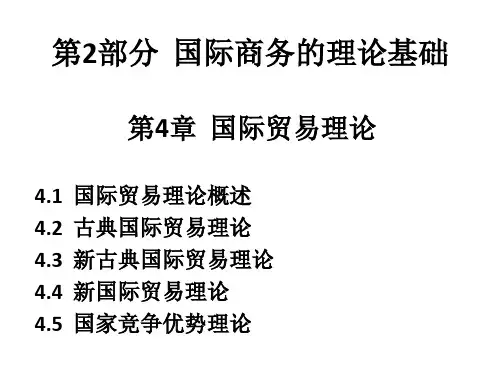
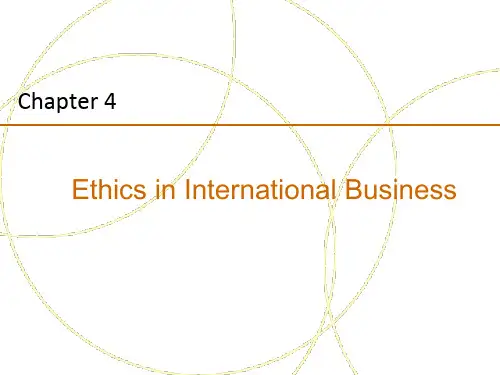
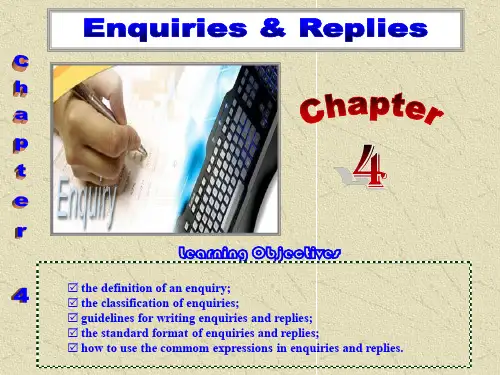
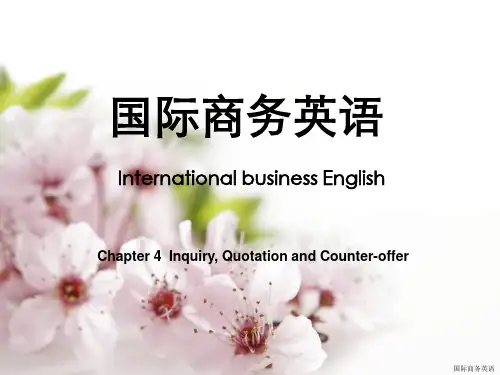
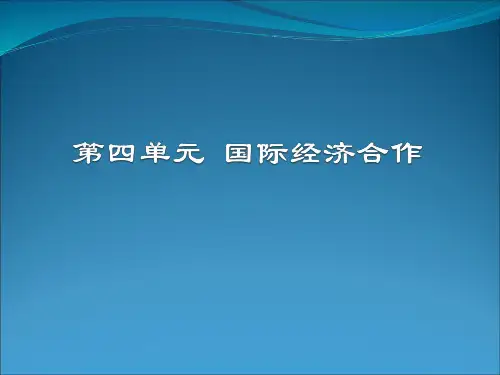
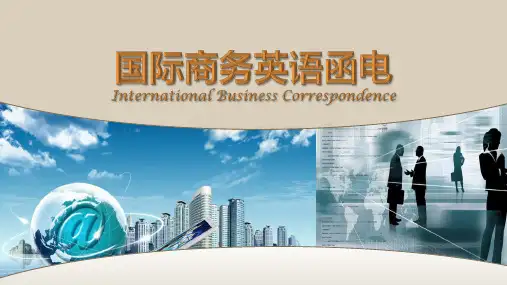
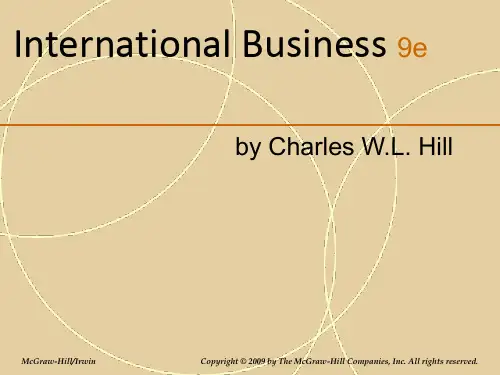
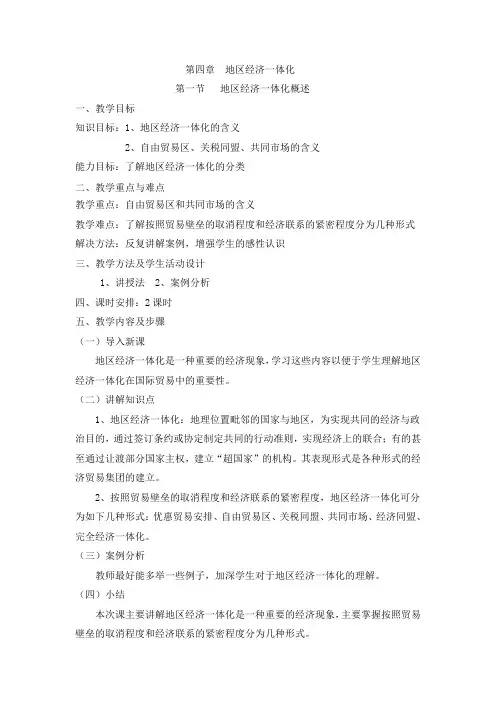
第四章地区经济一体化第一节地区经济一体化概述一、教学目标知识目标:1、地区经济一体化的含义2、自由贸易区、关税同盟、共同市场的含义能力目标:了解地区经济一体化的分类二、教学重点与难点教学重点:自由贸易区和共同市场的含义教学难点:了解按照贸易壁垒的取消程度和经济联系的紧密程度分为几种形式解决方法:反复讲解案例,增强学生的感性认识三、教学方法及学生活动设计1、讲授法2、案例分析四、课时安排:2课时五、教学内容及步骤(一)导入新课地区经济一体化是一种重要的经济现象,学习这些内容以便于学生理解地区经济一体化在国际贸易中的重要性。
(二)讲解知识点1、地区经济一体化:地理位置毗邻的国家与地区,为实现共同的经济与政治目的,通过签订条约或协定制定共同的行动准则,实现经济上的联合;有的甚至通过让渡部分国家主权,建立“超国家”的机构。
其表现形式是各种形式的经济贸易集团的建立。
2、按照贸易壁垒的取消程度和经济联系的紧密程度,地区经济一体化可分为如下几种形式:优惠贸易安排、自由贸易区、关税同盟、共同市场、经济同盟、完全经济一体化。
(三)案例分析教师最好能多举一些例子,加深学生对于地区经济一体化的理解。
(四)小结本次课主要讲解地区经济一体化是一种重要的经济现象,主要掌握按照贸易壁垒的取消程度和经济联系的紧密程度分为几种形式。
第二节地区经济一体化理论:关税同盟理论一、教学目标知识目标:1、关税同盟的含义2、贸易转移和贸易创造的含义能力目标:1、了解关税同盟的经济效应在于贸易转移和贸易创造所取得的实际效果。
2、了解关税同盟的动态经济效应二、教学重点与难点教学重点:关税同盟的含义教学难点:贸易转移和贸易创造的含义解决方法:反复讲解案例,增强学生的感性认识三、教学方法及学生活动设计1、讲授法2、案例分析四、课时安排:1课时五、教学内容及步骤(一)导入新课本次课主要讲解关税同盟理论,学习贸易转移和贸易创造所取得的实际效果。
(二)讲解知识点1、关税同盟,是指两个或两个以上国家缔结协定,建立统一的关境,在统一关境内缔约国相互间减让或取消关税,对从关境以外的国家或地区的商品进口则实行共同的关税税率和外贸政策。
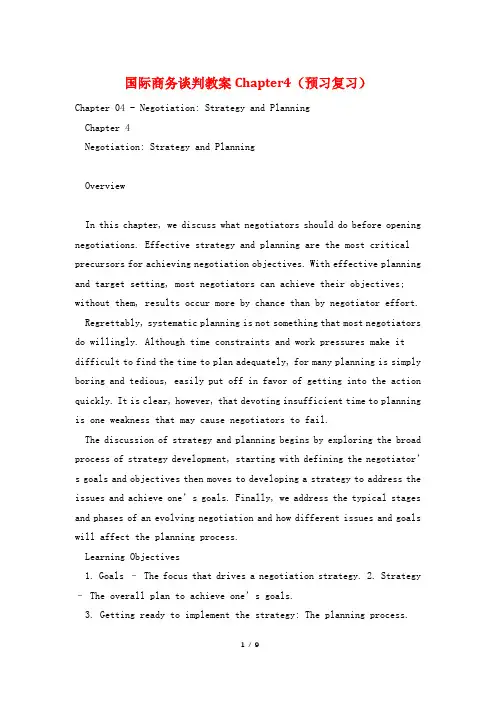
国际商务谈判教案Chapter4(预习复习)Chapter 04 - Negotiation: Strategy and PlanningChapter 4Negotiation: Strategy and PlanningOverviewIn this chapter, we discuss what negotiators should do before opening negotiations. Effective strategy and planning are the most critical precursors for achieving negotiation objectives. With effective planning and target setting, most negotiators can achieve their objectives; without them, results occur more by chance than by negotiator effort. Regrettably, systematic planning is not something that most negotiatorsdo willingly. Although time constraints and work pressures make it difficult to find the time to plan adequately, for many planning is simply boring and tedious, easily put off in favor of getting into the action quickly. It is clear, however, that devoting insufficient time to planningis one weakness that may cause negotiators to fail.The discussion of strategy and planning begins by exploring the broad process of strategy development, starting with defining the negotiator’s goals and objectives then moves to developing a strategy to address the issues and achieve one’s goals. Finally, we address the typical stages and phases of an evolving negotiation and how different issues and goals will affect the planning process.Learning Objectives1. Goals – The focus that drives a negotiation strategy.2. Strategy– The overall plan to achieve one’s goals.3. Getting ready to implement the strategy: The planning process.I. Goals – The Focus That Drives a Negotiation StrategyA. Direct effects of goals on choice of strategy1. There are four important aspects to understand about how goals affect negotiations: a. Wishes are not goals, especially in negotiation. b. Goals are often linked to the other party’s goals. c. There are boundaries or limits to what goals can be.d. Effective goals must be concrete, specific and measurable. If they are not, then itwill be hard to:(1) Communicate to the other party what we want (2) Understand what the other party wants(3) Determine whether an offer on the table satisfies our goals.2. Goals can be tangible or procedural.4-1Chapter 04 - Negotiation: Strategy and Planning3. The criteria used to determine goals depend on your specific objectives and your priorities among multiple objectives.B. Indirect effects of goals on choice of strategy1. Short-term thinking affects our choice of strategy; in developing and framing our goals, we may ignore the present or future relationship with the other party in a concern for achieving a substantive outcome only.2. Negotiation goals that are complex or difficult to define may requirea substantial change in the other party’s attitude. In most cases, progress will be madeincrementally, and may depend on establishing a relationship with the other party.II. Strategy – The Overall Plan to Achieve One’s GoalsA. Strategy versus Tactics1. A major difference between strategy and tactics is that of scale, perspective or immediacy.2. Tactics are short-term, adaptive moves designed to enact or pursue broad strategies, which in turn provide stability, continuity, and direction for tactical behaviors.3. Tactics are subordinate to strategy: they are structured, directed, and driven by strategic considerations.B. Unilateral versus bilateral approaches to strategy1. A unilateral choice is made without the active involvement of the other party.2. Unilaterally pursued strategies can be wholly one-sided and intentionally ignorant of any information about the other negotiator.3. Unilateral strategies should evolve into ones that fully consider the impact of the other’s strategy on one’s own.C. The dual concerns model as a vehicle for describing negotiation strategies. This model proposes that individuals have two levels of related concerns: a concern for their own outcomes, and a level of concern for the other’s outcomes.1. Alternative situational strategiesa. There are at least four different types of strategies when assessing the relativeimportance and priority of the negotiator’s substantive outcome versus the relational outcome: competitive, collaboration, accommodation, and avoidance2. The nonengagement strategy: Avoidancea. There are many reasons why negotiators may choose not to negotiate:(1) If one is able to meet one’s needs without negotiating at all, it may make sense to use an avoidance strategy(2) It simply may not be worth the time and effort to negotiate (although there are sometimes reasons to negotiate in such situations4-2Chapter 04 - Negotiation: Strategy and Planning(3) The decision to negotiate is closely related to the desirability of availablealternatives – the outcomes that can be achieved if negotiations don’t work out3. Active-engagement strategies: Competition, collaboration, and accommodation a. Competition is distributive win-lose bargaining. b. Collaboration is integrative or win-win negotiation.c. Accommodation is as much a win-lose strategy as competition, although it has adecidedly different image it involves an imbalance of outcomes, but in the opposite direction. (“I lose, you win” as opposed to “I win, you lose.”) d. There are drawbacks to these strategies if applied blindly, thoughtlessly orinflexibly:(1) Distributive strategies tend to create “we-they” or “superiority-inferiority” patterns, which may result in a distortion of the other side’s contributions, as well as their values, needs and positions.(2) If a negotiator pursues an integrative strategy without regard to the other’s strategy, then the other may manipulate and exploit the collaborator and take advantage of the good faith and goodwill being demonstrated.(3) Accommodative strategies may generate a pattern of constantly giving in to keep the other happy or to avoid a fight.III. Understanding the Flow of Negotiations: Stages and PhasesA. Phase models of negotiation:1. Initiation2. Problem solving3. ResolutionB. Greenhalgh (2001) suggests that there are seven key steps to an ideal negotiation process:1. Preparation: deciding what is important, defining goals, thinking ahead how to work together with the other party.2. Relationship building: getting to know the other party, understanding how you and the other are similar and different, and building commitment toward achieving a mutually beneficial set of outcomes.3. Information gathering: learning what you need to know about the issues, about the other party and their needs, about the feasibility of possible settlements, and about what might happen if you fail to reach agreement with the other side.4. Information using: at this stage, negotiators assemble the case they want to make for their preferred outcomes and settlement, one that will maximize the negotiator’s own needs.5. Bidding: the process of making moves from one’s initial, ideal position to the actual outcome.6. Closing the deal: the objective here is to build commitment to the agreement achieved in the previous phase.7. Implementing the agreement: determining who needs to do what once hands are shaken and the documents signed.4-3Chapter 04 - Negotiation: Strategy and PlanningIV. Getting Ready to Implement the Strategy: The Planning Process A. Defining the issues1. Usually begins with an analysis of what is to be discussed in the negotiation.2. The number of issues in a negotiation, along with the relationship between thenegotiator and the other party, are often the primary determinant of whether one uses a distributive or integrative strategy.3. In any negotiation, a complete list of the issues at stake is best derived from the following sources:a. An analysis of all the possible issues that need to be decided.b. Previous experience in similar negotiations.c. Research conducted to gather information.d. Consultation with experts in that industry.B. Assembling the issues and defining the bargaining mix1. The combination of lists from each side in a negotiation determines the bargaining mix.2. There are two steps a negotiator can use to prioritize the issues on an agenda: a. Determine which issues are most important and which are less important. b. Determine whether the issues are linked together or are separate.C. Defining Interests1. Interests may be:a. Substantive, that is, directly related to the focal issues under negotiation.b. Process-based, that is, related to how the negotiators behave as they negotiate.c. Relationship-based, that is, tied to the current or desired future relationshipbetween the parties.2. Interests may also be based on intangibles of negotiation.D. Knowing limits and alternatives1. Good preparation requires that you establish two clear points:a. Resistance point – the place where you decide that you should absolutely stop thenegotiation rather than continue.b. Alternatives – other agreements negotiators could achieve and still meet theirneeds. Alternatives define whether the current outcome is better than another possibility.E. Setting targets and openings1. Two key points should be defined in this step:a. The specific target point where one realistically expects to achieve a settlement4-4Chapter 04 - Negotiation: Strategy and Planningb. The asking price, representing the best deal one can hope to achieve.2. Target setting requires positive thinking about one’s own objectives.3. Target setting often requires considering how to package several issues and objectives.4. Target setting requires an understanding of trade-offs and throwaways.F. Assessing constituents and the social context of a negotiation1. When people negotiate in a professional context, there may be more than two parties. a. There may be more than two negotiators at the table. Multiple parties often leadto the formation of coalitions.b. Negotiators also have constituents who will evaluate and critique them.c. Negotiation occurs in a context of rules – a social system of laws, customs,common business practices, cultural norms, and politicalcross-pressures.2. “Field analysis” can be used to assess all the key parties in a negotiation. a. Who is, or should be, on the team on my side of the field?b. Who is on the other side of the field?c. Who is on the sidelines and can affect the play of the game? Who are thenegotiation equivalents of owners, managers and strategists?d. Who is in the stands? Who is watching the game, is interested in it, but can onlyindirectly affect what happens?e. What is going on in the broader environment in which the negotiation takesplace?f. What is common and acceptable practice in the ethical system in which the deal isbeing done?g. What is common and acceptable practice given the culture in which thenegotiation is conducted?G. Analyzing the other party1. Learning the other’s issues, preferences, priorities, interests, alternatives and constraints is almost as important as determining one’s own.2. Several key pieces of background information will be of great importance, including: a. The other party’s resources, issues, and bargaining mix – investigate:(1) Other party’s business history or previous negotiations. (2) Financial data. (3) Inventories.(4) Visit or speak with the other party’s friends and peers. (5) Question past business partners. b. The other party’s interests and needs.(1) Conduct a preliminary interview including a broad discussion of what the other party would like to achieve in the upcoming negotiations. (2) Anticipating the other party’s interests.(3) Asking others who know or have negotiated with the other party. (4) Reading how the other party portrays him/herself in the media.4-5。
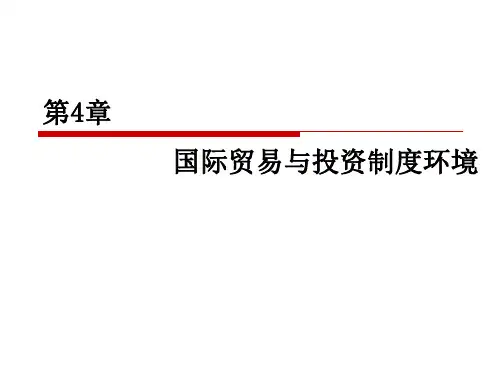
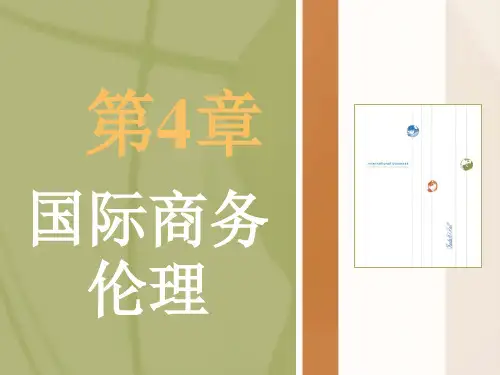
:名词解释1:国际分工:这世界上各国之间的劳动分工,他是社会分工发展到一定的阶段,国民经济内部分工超越国家内部发展的结果,是国际贸易和世界市场的基础2:服务贸易:依世界贸易【服务贸易总协定】的定义是指:过境交付,境外消费,商业性存在,自然人流动。
3:出口补贴:是一国政府为了降低商品的价格加强国际市场上的竞争能力,对出口商品给予出口商直接的现金补贴或间接的财政税收或运费等方面的优惠待遇4:最惠国待遇条款:指缔约国一方现在或将来所给与任何第三国的一切特权、优惠及豁免,也同样给与缔约对方,他要求的一切外国人或外国企业处于同等的地位,享有同等的优待。
5:绝对配额:在一定的时期内,对某些商品的数量或金额规定一个最高数额,达到这个数额后,便不准进口。
6:转口贸易:只在国际贸易中出口货物的买卖,不是在生产国和消费国之间直接进行的,而是通过第三国转与进行的贸易。
这种贸易对中转国来讲就是转口贸易。
7:自动出口配额限制:所为自动出口配额限制是出口国家或地区在进口国的要求或压力下“自动”规定某一时期(一般为3到5年)某些商品对该国的出口限制,在限定的配额内自行限制出口,超过配额即禁止出口。
他重要的特点是带有明显的强制性。
8:有效关税:指某个工业每单位产品“增值”部分的从价税率其税率代表着关税对本国工业同内产品的真正有效保护程度。
9:市场准入:是一种经过谈判后的具体承诺的义务,各国成员应为其他成员国服务与服务提供者能够进入市场提供可行渠道。
而这种渠道必须不低于其在具体承诺细目表上已同意的提供的条件和待遇。
10:出口信贷:是一种国际借贷方式,是指一个国家为鼓励商品出口,增强的竞争能力,是银行对本国或外国进口商提供的贷款。
简答题1•假定一国某种商品的需求曲线为D=40-2P,供给曲线为S=10+3P, 自由贸易时的世界市场价格为2,试问自由贸易下该国的进口量是多少?当该国对该种商品征收50%的从价关税时,试问该国的进口量是多少?解:1. 自由贸易时:S=10+3P=10+3x2=16D=40-2P=40-2x2=36进口量=D-S=36-16=202. 征收关税后:P=2x【1+50%】=3S=10+3P=10+3x3=19D=40-2P=40-2x3=34进口量二D-S=34-19=153. 简述大卫•李嘉图比较成本理论的主要内容大卫•李嘉图认为国家间应该“两优取其重,两劣取其轻” 的比较优势原则进行分工,即各国应集中力量生产那些利益较大或不利较小的商品,然后进行国际贸易,在资本和劳动力不变的情况下,生产总量将增加。
Chapter 4Business Ethics and Social Responsibility Chapter Objectives: After completing this chapter, you will be able to: Section 4.1 Business Ethics•Define ethics and business ethics.•Describe why ethical behavior is good for business.•List the steps for dealing with an ethical dilemma.Section 4.2 Social Responsibility•Define what is meant by the social responsibility of business.Duty-BoundBusinesses andcustomers both haveethicalresponsibilities.What are some ofyour ethicalresponsibilities?Section 4.1Business EthicsBefore you readThink about an example of an ethical business you have read or heard about and the reasons you consider it to be ethical.Read to Learn•Define ethics and business ethics.•Describe why ethical behavior is good for business.•List the steps for dealing with an ethical dilemma.The Main IdeaEthics are moral principles by which people conduct themselves personally, socially,and professionally. Business ethics are rules that guide the behavior of a business and its employees. Business ethics are generally based on moral principles. In business, good ethics is beneficial for long-term profitability and success.Key Concepts•The Nature of Ethics•Ethics as Good Business•Ethical QuestionsVocabularyKey Termsethics sweatshopbusiness ethics conflict of interestcode of ethicsAcademic VocabularyYou will find these words in your reading and on your tests. Make sure you know their meanings.principles encounterconduct alternativeThe Nature of EthicsEthics are moral principles by which people conduct themselves personally, socially, or professionally. For example, you do not cheat on a test or lie to friends or your family because of your personal honor and integrity. For the good of society, you may recycle to take care of the environment. Business ethics are rules based on moral principles about how businesses and employees ought to conduct themselves. Most businesses are committed to providing safe products, creating jobs, treating their employees fairly, protecting the environment, and being truthful about their financial situation.The effects of unethical behavior by customers are not always obvious. However, to make up for problems caused by unethical behavior, businesses have to charge more for their products. As a result, customers have to pay more.Different cultures, businesses, and industries have different ethical standards. For example, in some cultures, including the United States, excessive gift giving is considered bribery, which is unethical. Bribery occurs when gifts, money, or favors are offered to encourage a business deal. In other cultures, excessive gift giving is overlooked or considered ethical.Identify What are three kinds of ethics?Business Ethics Businesses have a set of moral principles that they follow.In what ways can a business behave ethically toward its employees?Law and EthicsEthics involve a system of moral principles that govern the appropriate conduct for a person or group. Laws involve rules for conduct that may be used to punish violators. In business, people follow rules as well as a code of ethics. A code of ethics is a set of guidelines for maintaining ethics in the workplace. Most businesses follow their own code of ethics. Figure 4.1 includes some findings about how employees feel about ethical behavior in their workplace.Many unethical behaviors lead to the passage of legislation that makes those behaviors illegal. In the United States, bad working conditions are not only unethical, they are also illegal. On March 25, 1911, a fire at the Triangle Shirtwaist Factory Company in New York City killed 146 workers—mostly young female immigrants. The business’s inadequate exit doors and fire escapes along with overcrowded conditions led to the deaths of the workers. This industrial tragedy brought about changes in laws governing conditions in sweatshops. A sweatshop is a shop or factory in which workers are employed for long hours at low wages and under unhealthy conditions.The Occupational Safety and Health Administration (OSHA) is a division of the U.S. Department of Labor. OSHA sets and enforces work-related health and safety rules. Other agencies protect consumers, address discrimination in the workplace, and promote truthfulness in financial reporting.A National Survey of Employees These are some of the key findings of a recent National Business Ethics Survey. Does American business seem to be becoming more or less concerned about ethical behavior?Ethics as Good BusinessMost businesses police themselves with codes of ethics. Professionals such as doctors, lawyers, journalists, and teachers have their own codes of ethics. A code of ethics can cover issues such as employee behavior and environmental safety. Unethical business practices include lying, offering merchandise known to be substandard, or treating customers or employees unfairly. If a business violates government regulations, the owner can be fined or go to jail. If an employee violates a company or professional code of ethics, the employee might be fired or lose his or her license. Not all unethical practices are covered by the law. Unethical business practices affect businesses indirectly.Suppose you own an auto-body paint shop. To increase your profits, you charge top price and use the cheapest paint. One of your customers complains about the quality of the paint, but you do not care because she has already paid. What is one customer, right? The fact is that most businesses (especially small businesses) rely on repeat customers and word of mouth to get new customers. The amount you make in profits from one unhappy customer may not be worth the lost business. Treating employees unethically can also backfire. Suppose you manage a small film distribution company. You hire Jaime fresh out of business school to run the office. You teach him how to use the computer system, how to deal with customers, and how the business works. You also pay him very little, make him do all your work, and treat him poorly. The first chance Jaime gets, he quits and ends up being hired by one of your competitors. You now have to retrain a new employee to take his place. Meanwhile, your competition now has a well trained employee, who is much more efficient.Conflicts of InterestAnother major ethical question that is generally not illegal relates to conflict of interest. A conflict of interest is a conflict between self-interest and professional obligation. Suppose that a manager of a small business hires his sister to do some work in the firm, but she is clearly unqualified to do the work. Giving the position to the sister will help out the family but will create morale problems with the other employees. It may also damage the business if her work does not get done. When making business decisions, employees have an ethical obligation to act in the best interest of the company.Ethical QuestionsWhen you encounter an ethical decision and must choose a course of action, ask yourself these important questions:•Is it against the law? Does it violate company or professional policies?•Even if everyone is doing it, how would I feel if someone did this to me?•Am I sacrificing long-term benefits for short-term gains?The Ethical Decision-Making ProcessHere are some steps to take if you find yourself in an ethical dilemma:1. Identify the ethical dilemma.2. Discover alternative actions.3. Decide who might be affected.4. List the probable effects of the alternatives.5. Select the best alternative.Using this process will enable you to make a more informed ethical choice. Making an ethical decision involves more people than just you.Review Key Concepts1. What is the difference between personal and business ethics?2. Describe some of the ways that unethical business practices can affect a business.3. What is the relationship between illegal behaviors of business and unethical behaviors of business?Academic Skills4. Mathematics A large company decided it would give 1/8 of its profits to charity. Ifthe amount given was spread equally among five different charities, what fraction of the company’s profits was given to each? What percent of the company’s profits is this?Number and Operations: Dividing Fractions To divide a fraction, invert the divisor and multiply.Section 4.2Social ResponsibilityBefore you readThink about some things a business can do to be socially responsible.Read to Learn•Define what is meant by the social responsibility of business.The Main IdeaSocial responsibility is the duty to do what is best for the good of society. Producing goods and services that are beneficial to society and providing jobs for people are not sufficient for a business to be considered socially responsible. They are expected to do more. Many businesses provide money for projects that benefi t society.Key Concept•Business and Social ResponsibilityVocabularyKey Termsocial responsibilityAcademic VocabularyYou will find these words in your reading and on your tests. Make sure you know their meanings.integrity benefitintegral sufficientBusiness and Social ResponsibilityBusiness ethics focus on decisions considered good or bad, correct or incorrect. The social responsibility of business takes into consideration all that business does or does not do to solve the problems of society. Social responsibility is the duty to do what is best for the good of society. Businesses that follow ethical standards value integrity and honesty in employees. Ethics are an integral part of their business practices. Some people believe that if a company produces goods that benefit society, it is fulfilling its social responsibility. However, many people and businesses do not think that is sufficient. They consider social responsibility to be more than that. Some firms are very concerned about limiting the damage that they do to the environment. The Los Angeles Times, a daily newspaper with more than 1million readers, uses recyclable paper and environmentally friendly soy-based ink. Automakers such as Honda and Toyota offer eco-cars, which reduce air pollution. Explain What ways can a business fulfill its social responsibilities?Responsibility to CustomersCustomers are a business’s first responsibility. Businesses should offer a good, safe product or service at a reasonable price. The Food and Drug Administration (FDA) is a federal government agency that protects consumers from dangerous or falsely advertised products. Most companies obey the government’s rules.Some companies do not act responsibly in the marketplace, especially when it comes to fair competition. Fair competition between businesses is necessary for the marketplace to operate effectively. It is a major component of a market economy. The market economy relies chiefly on market forces to allocate goods, services, and other resources, and to determine prices. Some companies use unethical tactics to eliminate competition. One of the most common means is to conspire with other companies to control the market for a product. Together, the companies can control the supply of a product and the prices they charge.When companies restrict competition, consumers are affected. Consumers have fewer choices in what they can buy and how much they have to pay. When a company does not have to compete, its productivity decreases. This can backfire on a business. When the market changes or new markets open up, a company can find itself unprepared to compete. For example, in the 1940s, a handful of entertainment studios controlled the film industry. They kept control by owning most of the theaters. Smaller studios could make movies, but they could not get them shown anywhere. The government sued the big studios and forced them to sell their theaters. As a result, small studios were able to compete in the marketplace.A Community Concert People enjoy going to community concerts. How could a business demonstrate social responsibility by participating in an event like this?Responsibility to EmployeesSome businesses provide work experience for people with limited job skills. Many of these people are public assistance recipients. The purpose of such programs is to develop the skills and confidence levels necessary for success.Volunteerism is another way businesses tackle societal problems. Some companies allow employees to take one or more paid days off during the year to work on community projects.Businesses have a social responsibility to provide employees with safe working conditions, equal treatment, and fair pay. Less than 100 years ago, however, workers had few rights. Over the years the government has passed laws to protect workers from a range of issues, from child labor abuses to the rights of workers to organize. As the workplace has changed, the government has passed new laws. The Equal Pay Act (passed in 1964) requires that men and women be paid the same wages for doing equal work. More than 40 years later, however, the gap still exists. Another law, the Americans with Disabilities Act, bans discrimination against people with physical or mental disability. More than 50 million workers are likely to be covered by this law.It is in a company’s best interest to treat its workers fairly. Otherwise, it may suffer from low morale, poor production, and a high turnover rate.Responsibility to SocietyBusinesses have responsibilities not only to customers and employees but also to society. One of the biggest social issues facing businesses today is environmental responsibility. In 1970, the U.S. government created the Environmental Protection Agency (EPA), which enforces rules that protect the environment and control pollution.Identify What is one of the biggest social issues facing businesses today?Responsibility to Creditors and OwnersIn the late l990s and the early part of the 21st century, a number of major corporations reportedly kept inaccurate accounting records. Records showed that the firms had higher profits than they reported. Their behaviors were unethical and unlawful. Such behaviors are harmful to creditors (those who loan money) and outside shareholders (those who are owners but do not work in the business). Because of these behaviors, the federal government passed additional legislation. The Sarbanes-Oxley Act mandates truthful reporting and makes the CEO more accountable for the actions of the financial managers of a firm.Section 4.2Review Key Concepts1. How is producing a good or service a way of being socially responsible?2. What is the mission of the Food and Drug Administration?3. What is one of the biggest social issues that businesses face today?Academic Skills4. English Language Arts Situations involving ethics and social responsibility are not found only in the business world. They come up in everyone’s dayto- day life. Write a paragraph explaining an ethical decision made by you or someone you know. Explain what made it an ethical decision and the steps that were taken to make the final decision.5. English Language Arts The terms below all relate to business ethics. Imagine that you are asked to explain these terms to a group of sixth-grade students who are just beginning to study how businesses work. Plan a talk designed to define each term. Give examples that might help a sixth grader understand the ideas. code of ethics conflict of interest social responsibility volunteerismVocabulary Review1. On a sheet of paper, use each of these key terms and academic vocabulary terms in a sentence.Key Termsethicsbusiness ethicssweatshopcode of ethicsconflict of interestsocial responsibilityAcademic VocabularyprinciplesconductencounteralternativeintegrityintegralbenefitsufficientReview Key Concepts2. Define ethics and business ethics.3. Describe why ethical behavior is good behavior for business.4. Using the ethical decision-making process, list the steps for dealing with an ethical dilemma.5. Define what is meant by the social responsibility of business.Critical Thinking Write About It6. Give an example of an unethical decision that is not illegal. Can a legal decision also be an unethical one?7. Do you think the United States should trade with countries that have a poor human rights record? Why or why not?8. Why do you think businesses with written codes of ethics and ethics programs for their employees have fewer ethical problems than other companies?9. One study showed that young, inexperienced managers are twice as likely to feel pressured to compromise ethical standards as their older counterparts. Why do you think that is true?10. Why do you think that some employees tell their managers about unethical behaviors of other workers? Do you think this is a good development?11. Imagine that your manager says she cannot give you a raise but will allow some personal items in your travel expense report. What impression does that give you of her professional ethics?12. Is ethical behavior always easy? Why or why not? What can a person do to make the best decision regarding an ethical dilemma?13. Some people believe that to solve social problems, money should come from government, not businesses. Write a letter to the editor of your local newspaper about your opinion of this stance.14. Imagine that you discover your company is cheating the government out of thousands of dollars each year. Write a short essay about your options in this case.15. In a paragraph or two, describe a situation in which you showed ethical behavior that resulted in some positive reactions from others.16. Think of a business that you believe shows ethical behavior. Write a letter to the business owner about your observations.17. Write an e-mail to your teacher discussing whether the drive to maximize profits is the reason some businesses are ethical and others are unethical.18. Businesses have an ethical responsibility to their employees. Describe the typeof ethics you would look for in an employer.19. Write at least two paragraphs detailing ways that the government has helpedworking people.Technology ApplicationsInternet20. Using the Internet, select three codes of ethics from various professions (such as the medical, legal, educational, and accounting fields) or businesses. Compare and contrast the codes of ethics. Report your findings to the class.Business EthicsMaking Ethical Decisions21. What would you do if a friend at work was making about $100 worth of personal phone calls each month? Would your answer be different if the cost were $10 a month? Use the ethical decision-making process to determine what you should do.Chapter 4 Review and Activities Applying Academics to BusinessEnglish Language Arts22. Each of the following sentences contains a grammatical mistake. Identify the errors, and rewrite the sentences to make them correct.A. Businesses must concerned with environmental issues.B. Most nonprofit organizations are social responsible.Mathematics23. Jimmy’s company had a code of ethics that only allowed its sales representatives to accept gifts from clients if they cost less than 1/8 of the employee’s yearly bonus. The bonuses were equal to 1/36of the employee’s total sales for the year. If Jimmy’s total sales equaled $58,000, could he ethically accept a $250 TV from a client?Number and Operations:Multiplying Fractions Multiply fractions by multiplying the numerators and then multiply the denominators. To find how much Jimmy’s bonus will be, multiply $58,000 by 1/36 . Then multiply that product by 1/8 .English Language Arts24. Read the following phrases and note the underlined words. Write a sentence describing what they have in common and naming their part of speech.decision-making process short-term goalsMathematics25. A manufacturing company with 8 million shareholders normally pays a $2 dividend per share at year-end. Because of an unexpected $20 million windfall in profits, one member of the board of directors proposes raising the dividend by 40 percent and reserving $15 million for future environmental cleanup operations. Is there enough extra money to do both?Problem Solving Solving word problems sometimes requires several mathematical steps. Read the situation described carefully in order to figure out what the steps should be. To better understand the problem, you might try restating the question: Is $20 million greater than the additional dividend paid to shareholders plus the $15 million reserve?Active LearningDealing with a Dilemma26. Ask a family member if he or she has ever been faced with an ethical issue at work. If so, find out what happened and how it was resolved. Ask that person to explain the steps in making an ethical decision. Write two paragraphs listing what you learned from your conversation.Business in the Real WorldInterview a Businessperson27. Interview a manager of a business in the local community. Ask the manager if the business has a code of ethics and how it is enforced. What are some common violations of the code? Ask for at least three experiences in which ethical behavior was beneficial to the firm. Then prepare a report based on your findings.Real Life SkillsD EVELOPE THICAL S KILLS28. As a class, create a formal code of ethics for the classroom. Be sure to include the purpose of the code, the rules for classroom behavior, the steps for making ethical decisions, and the consequences of breaking the code. Use the code of ethics in the class for the remainder of the year. Revise as needed.Role PlayB UILDING ON A H ISTORIC S ITE30. Situation Your firm wants to put up an apartment building on a site where the oldest building in town currently rests. The people in the area are very interested in historical preservation.Activity When the initial planning for the apartment building was made, there was no idea that this property was historically significant. Prepare a report to the president of your firm with recommendations for the project.Evaluation Your report will be evaluated on how well you meet the following performance indicators:•Explain alternate courses of action.•Explain the ethical implications of proceeding with the project.•Describe the community’s reaction to the project.•Demonstrate an understanding of the ethical decision-making process.Unit 1 Thematic ProjectTrends in the World of BusinessThe business world is constantly changing. To meet the challenges of the dynamic business environment, businesses and workers need to understand and react to trends.Thematic Project AssignmentIn this project, you will research trends that are affecting businesses and careers and write a report about them. These trends include the rise of globalization, the evolution of technology, and the increasing importance of cultural diversity.Step 1 Brainstorm Skills You Need to Complete This ActivityYour success in business will depend on your skills. Preview the activity, then brainstorm a list of the skills you will need to use to complete the activity and describe how you will use them. Skills you might use include:Academic Skills reading, writing, math, and science skillsBasic Skills speaking, listening, thinking, problem-solving, and interpersonal skills Technology Skills word processing, keyboarding, database, spreadsheet, presentation, telecommunications, and Internet skillsStep 2 Choose a Business and a Career That Interest YouThink of a business that you find interesting. Then think of a career that interests you. As you investigate trends in business, you will research the effects of globalization, technology, and cultural diversity on the business and career of your choice.Step 3 Build Background KnowledgePreview the business trends you will research.Step 4 Connect with Your CommunityInterview an adult family member about how the business world has changed. Find out what the workplace was like when he or she first entered the workforce.Step 5 Research Business TrendsUse library and Internet resources to research business trends. Use the Preview Project checklist as a guide to your research. Keep records of your sources of information.Step 6 Develop a ReportUse word processing and other software to develop a two-page report that includes all of the information described in this checklist.Business Trends✔Describe globalization and the factors that have promoted globalization.✔Describe the effect of globalization on businesses and the job market.✔Create a time line showing the technological innovations that have promoted globalization.✔Describe how technology has changed the global business environment.✔Explain how technological change has created new businesses and affected existing businesses and jobs.✔Describe how diversity creates an advantage for businesses.✔Use information from the U.S. Census Bureau to create a chart that compares the U.S. population today with projections for the population in 2050.Self Connections✔Describe the results of your interview with an adult family member.✔Describe how technology, globalization, and diversity have affected the business and career in which you are interested.✔Explain what the investigation and its results mean to you.Step 7 Evaluate Your Report。